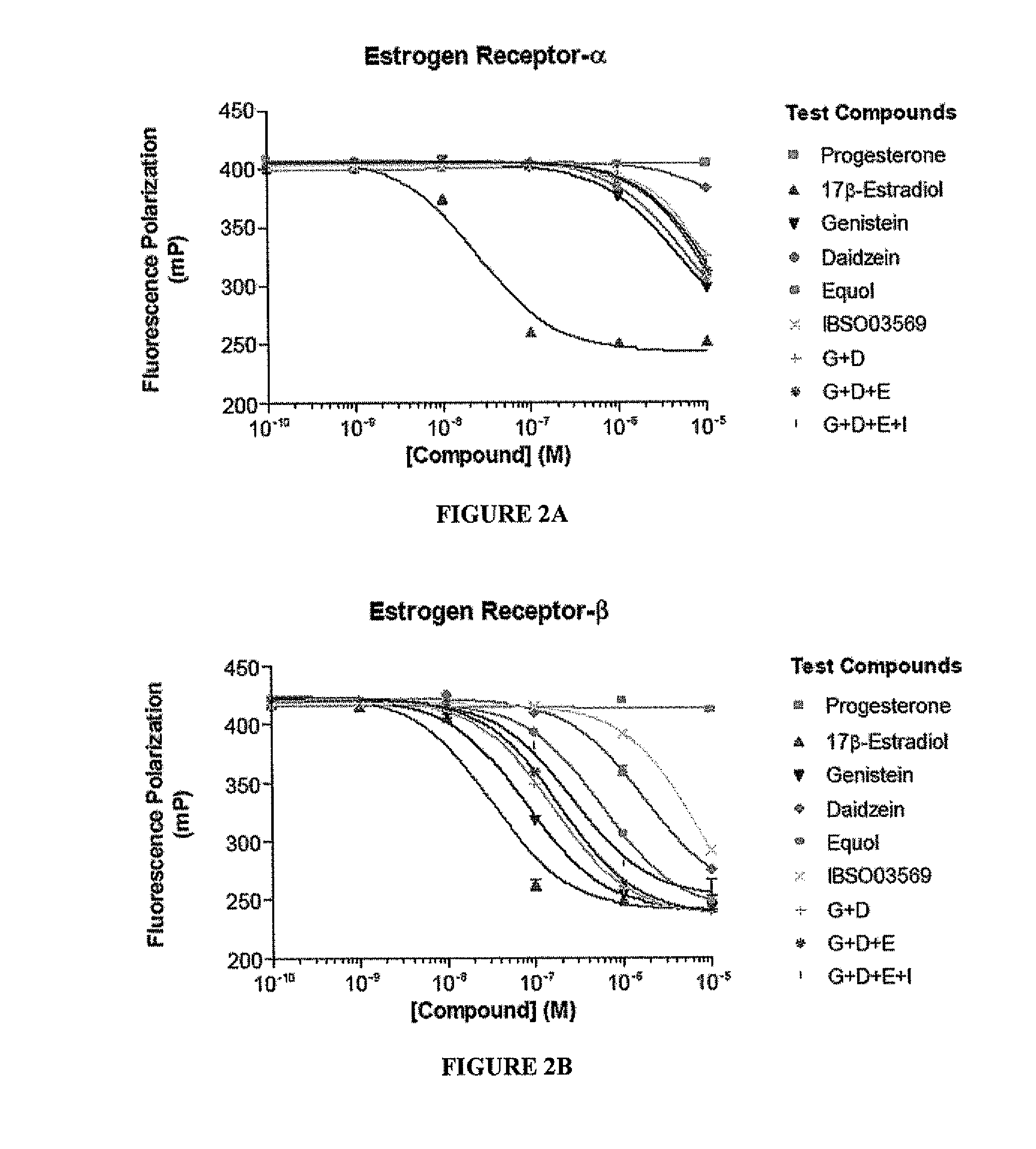Phytoestrogenic formulations for alleviation or prevention of hair loss
a technology of phytoestrogenic formulations and hair loss, which is applied in the direction of anti-noxious agents, peptide/protein ingredients, metabolic disorders, etc., can solve the problems of double danger for women, shortening the hair growth cycle, and potential long-term risks of this therapy, so as to promote estrogenic effects and be safe for both women
- Summary
- Abstract
- Description
- Claims
- Application Information
AI Technical Summary
Benefits of technology
Problems solved by technology
Method used
Image
Examples
example 1
Identification of PhytoSERMs
[0112]ERβ has been associated with estrogen-induced promotion of memory function and neuronal survival. Based on the optimized complex structure of human ERβ LBD bound with genistein, computer-aided structure-based virtual screening against a natural source chemical database was conducted to determine the occurrence of plant-based ERβ-selective ligands. Twelve representative hits derived from database screening were assessed for their binding profiles to both ERs, three of which displayed over 100-fold binding selectivity to ERβ over ERα.
[0113]Materials and Methods
[0114]Identification of Compounds in Database
[0115]The ligand binding domains of the human ERα and ERβ are approximately 60% homologous. Structural modeling and mutational analyses indicate that two variant amino acid residues along the ligand binding pocket, Leu 384 and Met 421 in ERα, which are replaced with Met 336 and Ile 373, respectively, in ERβ, are the key molecular constituents underlyi...
example 2
A phytoSERM Formulation that Selectively Binds ERβ Prevents Ovariectomy (OVX)-Induced Hair Thinning in Mice
[0128]Methods and Materials
[0129]Custom Diets
[0130]Three rodent diets were custom manufactured by Harlan Laboratories (Madison, Wis.). The Control Diet, which also served as the base diet for the other two diets, was prepared from Teklad Global 16% Protein Rodent Diet (Harlan Laboratories), which was ground and re-pelleted. This diet has a fixed formula and is nutritionally balanced containing 16% protein and 3.6% fat that support the growth and maintenance of rodents. This diet does not contain alfalfa or soybean meal, thus minimizing the occurrence of natural phytoestrogens. The Phyto-β-SERM Diet was prepared by adding equal parts of genistein, daidzein and equal (LC Laboratories, Woburn, Mass.), 0.0333 g / kg each, to the base diet. Total addition sums to approximately 100 mg (genistein, daidzein and equal) / kg diet. This diet delivers 10 mg added phyto-β-SERM formulation / kg mo...
example 3
Phyto-β-SERM Formulation Prevents Physical and Neurological Changes in a Preclinical Model of Human Menopause
[0152]Methods and Materials
[0153]Custom Diets
[0154]Three rodent diets were custom manufactured by Harlan Laboratories (Madison, Wis.). The composition of each diet is listed in Table 2. The Base / Control Diet was prepared from Teklad Global 16% Protein Rodent Diet (Harlan Laboratories), which was ground and repelleted. This diet has a fixed formula and is nutritionally balanced containing 16% protein and 3.6% fat that support the growth and maintenance of rodents, and does not contain alfalfa or soybean meal, thus minimizing the levels of natural phytoestrogens. The Phyto-β-SERM Diet was prepared by adding equal parts of genistein, daidzein and equal (LC Laboratories, Woburn, Mass.) to the base diet. A total of 100 mg (genistein, daidzein and equal) was added per 1000 g diet. This diet would deliver to a mouse a daily intake of 0.25 mg added phyto-β-SERM formulation (genistein...
PUM
| Property | Measurement | Unit |
|---|---|---|
| time | aaaaa | aaaaa |
| time | aaaaa | aaaaa |
| time | aaaaa | aaaaa |
Abstract
Description
Claims
Application Information
 Login to View More
Login to View More - R&D
- Intellectual Property
- Life Sciences
- Materials
- Tech Scout
- Unparalleled Data Quality
- Higher Quality Content
- 60% Fewer Hallucinations
Browse by: Latest US Patents, China's latest patents, Technical Efficacy Thesaurus, Application Domain, Technology Topic, Popular Technical Reports.
© 2025 PatSnap. All rights reserved.Legal|Privacy policy|Modern Slavery Act Transparency Statement|Sitemap|About US| Contact US: help@patsnap.com



